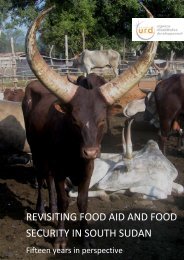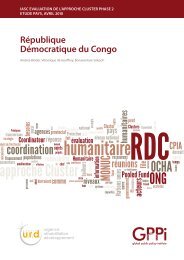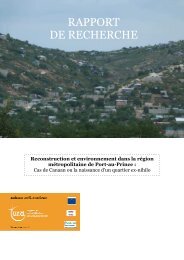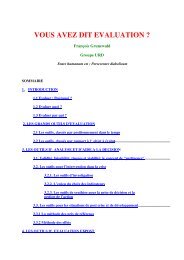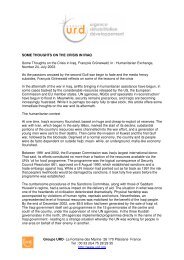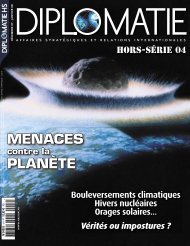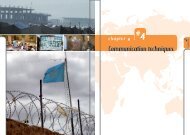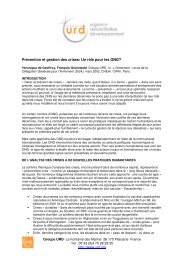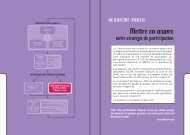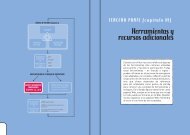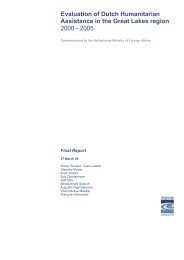Kabul Urban Survey - Groupe URD
Kabul Urban Survey - Groupe URD
Kabul Urban Survey - Groupe URD
Create successful ePaper yourself
Turn your PDF publications into a flip-book with our unique Google optimized e-Paper software.
- This analysis was used for the “Afghanistan: <strong>Kabul</strong> <strong>Urban</strong> Reconstruction Project” 55 , a<br />
Technical Annex document of the International Development Association (IDA) in July<br />
2004.<br />
- On 13-15 August 2005, a meeting was held for the “KURP Project launch program” with<br />
the MoF, the MUDH, KM, the MOI, the World Bank, and with the participation of UN-<br />
HABITAT and the Agar Khan Trust for Culture (AKTC).<br />
- Several technical programmes are included in the KURP: Afghanistan <strong>Urban</strong> Waste<br />
Management Project, Afghanistan <strong>Urban</strong> Land Management and <strong>Kabul</strong> University <strong>Urban</strong><br />
Learning Program.<br />
- The “<strong>Kabul</strong> <strong>Urban</strong> Reconstruction Project” was presented by the PMU Team, and Eng.<br />
ABDUL AHAD (W), Leader KURP/MUDH in November 2005.<br />
Rehabilitation issues<br />
Need for rehabilitation guidelines<br />
Further to this rehabilitation programme, there is a need for guidelines for all types of<br />
programme being implemented in the city: rehabilitation of the old centre with<br />
preservation of urban and architectural heritage, as well as any restoration in the city.<br />
6.2.2 Development vision, programmes and risks<br />
“<strong>Kabul</strong> has grown at a rate of approximately 15% per year since 1999 and its projected<br />
growth is 5% (3 migrants, 3% natural growth), representing 150 000 new people per year.<br />
This burgeoning growth has raised debates on how accommodate the city’ expansion and<br />
how to develop the existing city.” 56 In order to resolve some urban issues, especially housing<br />
needs over the next few years due to population growth, there are two strategies:<br />
- Afghan authorities would like to expand the city through the creation of a new <strong>Kabul</strong> city<br />
outside the existing urban area;<br />
- The main international urban actors with the World Bank recommend an approach based<br />
on various phases that will be implemented on different timescales and in different areas.<br />
• Point of view of international organisations<br />
Existing settlements cannot be displaced without provoking riots. The “informal settlements”<br />
have the financial advantage that they have already been built and the building has been<br />
funded by their inhabitants. The population participates in <strong>Kabul</strong>’s economy: not everyone in<br />
illegal or informal situations is poor.<br />
To a certain extent, international aid and international funds for the reconstruction of the<br />
country can be understood as aid for the rehabilitation of an existing situation. In 2006, the<br />
World Bank raised the question “Should <strong>Kabul</strong> grow by expanding to a new town or by<br />
building up its existing suburbs” and put forward the following response: “the answer lies in<br />
its existing spatial and built-up environment 57 ”.<br />
• The Afghan point of view<br />
The initial reasoning of Afghan stakeholders was simple: the 1978 Master Plan laid down<br />
plans for <strong>Kabul</strong> city for 2 million inhabitants. Today, the population is estimated at around 4<br />
million and is increasing every day so therefore it was deemed necessary to build a new city<br />
for 2 million people. Another strategy put forward by the Afghan government was to give the<br />
private sector the necessary space, with the idea that private investment, via entrepreneurs<br />
or private companies, could be found for the new town, with an adequate road network and<br />
infrastructure, plus the possibility of developing different types of buildings, such as markets,<br />
resorts, etc.<br />
55 IDA, International Development Association, July 2004 “Afghanistan: <strong>Kabul</strong> <strong>Urban</strong> Reconstruction<br />
Project”, Technical Annexe<br />
56 World Bank, January 2006 <strong>Kabul</strong> <strong>Urban</strong> Policy notes Series n°3<br />
57 World Bank, idem note n 51<br />
Page 67



